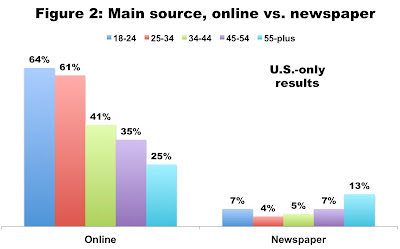Study finds elders pick web over newspaper, too
While it has become increasingly clear for some time that younger individuals are more inclined than their elders to use digital sources to keep up with the news, publishers generally were confident that they continued to enjoy the loyalty of middle-aged and older readers.
But an ambitious survey of 10,843 individuals in nine countries has found that a majority of consumers in every age group now cite online media over printed newspapers as their main source for news. The study, which is freely available here, was conducted by the Reuters Institute for the Study of Journalism at Oxford University. It polled individuals in the “urban” portions of Brazil, as well as throughout the entire countries of Denmark, France, Germany, Italy, Japan, Spain, United Kingdom and United States.
Because the survey was conducted only online, “the results will under-represent the consumption habits of people who are not online,” said David A.L. Levy, the director of the institute in an introduction to the findings. He described offline individuals as “older, less affluent and with limited formal education.”
As such, the survey undoubtedly undercounts individuals who still rely on newspapers and television as their primary sources for news. Despite this limitation, the findings demonstrate a consistent and unmistakable generational divide in media consumption in all of the countries surveyed.
As illustrated below in Figure 1, more than half of the global respondents in the 18-34 age groups preferred online sources over newspapers as their principal source for news. By contrast, only 7% of those under the age of 35 cite newspapers as their primary information outlet.
The really surprising finding is that online venues are cited as the main news source by every group of older respondents, too. In the 45-54 cohort, 32% of respondents chose online as their main news source vs. 11% for newspapers. Even in the oldest group, 55-plus, online sources edged newspapers by 21% to 18%.
In the United States, the digital tilt is even more pronounced. As illustrated in Figure 2, supplemental survey data generously provided by Nic Newman, a co-author of the study, shows a stronger preference in most age categories for online news consumption in the U.S. than identified around the globe. In a finding that should be particularly chilling for publishers, Americans rely significantly less on newspapers than respondents around the world.
Attempting to measure news consumption in another way, the Oxford researchers asked respondents in all nine countries what media they used in the course of a week.
While more than three-quarters of those in the under-45 category said they went online, fewer than a third of the respondents in the three youngest groups said they read a newspaper. As illustrated in Figure 3, more than 70% of those over 45 accessed online sources for news, substantially surpassing the number of individuals consulting newspapers in the two most senior age brackets. While those over the age of 55 were the most avid newspaper readers, barely 54% of them consulted papers vs. 72% who used the web. The responses from Americans mirrored the global findings, though there was a notably stronger preference for digital than print among U.S. respondents.
Turning to television, the other major legacy news medium, the Oxford researchers found a strong preference for online news over TV among younger individuals.
While more than half of those in the two youngest age groups cited online media as their main news source in the nine-country survey, fewer than a third of the respondents in the youngest cohorts favored television. As illustrated in Figure 4, the preference for TV surpassed the web for only those in the 45-plus age groups. The distribution in the United States mirrors the V-shaped spread shown below, where online usage the highest among the most youthful consumers and TV usage is highest among the older respondents.
Taken individually and collectively, these sweeping shifts in consumer behavior pose a profound challenge to the immediate economics and long-term viability of nearly every publisher and broadcaster. The stakes are high, because companies in the business of selling access to readers and viewers cannot survive if their audiences go away.
The above examples reflect only a smattering of the rich data available in the Oxford study. Anyone who cares about the health of the businesses paying for most journalism today should read the whole thing. You can find it here.







